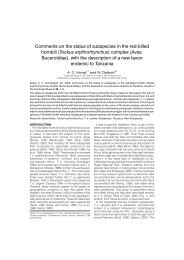EAZA Hornbill Management and Husbandry Guidelines
EAZA Hornbill Management and Husbandry Guidelines
EAZA Hornbill Management and Husbandry Guidelines
You also want an ePaper? Increase the reach of your titles
YUMPU automatically turns print PDFs into web optimized ePapers that Google loves.
Dimensions of the nest entrance are of great importance for most hornbill species; they<br />
prefer an oval, elongated entrance (Poonswad et al., 1987). Shape of nest entrances used<br />
by four hornbill species in Thail<strong>and</strong> are shown in Appendix 11.G. A small entrance helps<br />
to keep intruders out <strong>and</strong> is easier to seal (see Section 6.3.4: Plastering the nest opening).<br />
The entrance does not have to be much wider than the width of the female from shoulder<br />
to shoulder when the wings are drawn in (Kemp, 1995). This is approximately 15 to 17<br />
cm for the larger Asian hornbill species (Poonswad, 1994). The mean width of 32 great<br />
hornbill Buceros bicornis nest entrances in Thail<strong>and</strong> was 13.5 cm (range 7.4-25.5 cm.)<br />
<strong>and</strong> mean length of the entrance 40.5 cm (range 14.8-71.6 cm). The bottom of the nest<br />
entrance was 0- 7 cm from the nest floor (Poonswad et al., 1988).<br />
The width of the opening (Figure 4: E) should be the width of the shoulders plus 10%.<br />
The floor depth (Figure 4: C) should be sufficient to allow the female to add lining<br />
material to the nest floor, e.g. wood shavings <strong>and</strong> leaves. The female <strong>and</strong> the chick(s)<br />
must be able to reach the opening to defecate through the entrance so that the nest<br />
remains clean. If the nest entrance is quite long (Figure 4: D), almost to the bottom of the<br />
nest box, the female can plaster the entrance to the height (from the bottom of the nest<br />
box) that she wants to close the nest entrance.<br />
The thickness of the wall next to the opening should be 3 cm or more, otherwise the<br />
sealing material may fall out of the entrance (A. Kemp, pers. comm.).<br />
Table 6. Suggested measurements for artificial hornbill nest features illustrated in Figure 4 for some<br />
hornbill taxa, based on mean taxon size (weight).<br />
Species Weight (g) Measurements (cm)<br />
A ØB B1 B2 C D E<br />
Tockus spp. 80-160 30 20 20 20 5 15 5-10<br />
Tockus spp.,<br />
Ocyceros spp.,<br />
Ceratogymna f.<br />
fistulator<br />
161-320 50 20 20 20 5-10 15 5-10<br />
Tockus spp.,<br />
Penelopides spp.,<br />
Ceratogymna spp.<br />
321-640 70 30 30 30 10 20 10<br />
Anorrhinus spp,<br />
Aceros spp.,<br />
Anthracoceros spp.,<br />
Ceratogymna spp.,<br />
Buceros hydrocorax<br />
641-1280 90 50 50 50 10 25 14<br />
Buceros spp., Aceros<br />
spp.<br />
1281-2560 130 60 60 60 15 >35 17<br />
48




